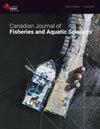对特洛伊木马(MYY)溪鳟(Salvelinus fontinalis)繁殖性能的实验室评估
IF 2.2
2区 农林科学
Q2 FISHERIES
Canadian Journal of Fisheries and Aquatic Sciences
Pub Date : 2024-04-08
DOI:10.1139/cjfas-2023-0245
引用次数: 0
摘要
加拿大渔业与水产科学杂志》(Canadian Journal of Fisheries and Aquatic Sciences),提前出版。 评估使用带有两条Y染色体的特洛伊雄性鳟鱼(MYY)的效果需要更好地了解其繁殖性能。我们利用实验室杂交方法测量了孵化的0龄和1龄MYY鳟鱼与孵化的XY雄性鳟鱼的繁殖性能比较。XY雄鱼的后代在受精后1天的存活率比1龄MYY的后代要高,但0龄MYY的后代则没有。我们没有发现从卵到幼鱼阶段的存活率有任何差异。但是,年龄大小却有差异,0龄 MYY 的后代比 XY 雄性的后代体长小 3.6%,体重小 25.2%。对于由 MYY 雄性和 XYY 雄性受精的杂交,我们发现,由 MYY 雄性和 XYY 雄性受精的家系后代比例显著高于由 XYY 雄性受精的家系后代比例。这些结果表明,在受控条件下,有证据表明 MYY 在精子竞争中可能具有适应性优势,但其后代的早期生长可能会导致适应性劣势。总之,我们的研究结果为利用 MYY 锦鳟鱼作为有效的根除工具带来了希望。本文章由计算机程序翻译,如有差异,请以英文原文为准。
Lab-based evaluation of the reproductive performance of Trojan (MYY) brook trout (Salvelinus fontinalis)
Canadian Journal of Fisheries and Aquatic Sciences, Ahead of Print.
Evaluating the efficacy of the use of Trojan male brook trout with two Y chromosomes (MYY) requires a better understanding of reproductive performance. We measured the reproductive performance of hatchery age-0 and age-1 MYY brook trout compared to hatchery XY males using laboratory crosses. Offspring of XY males had higher survival than offspring of age-1 MYY 1-day post-fertilization, but not offspring of age-0 MYY. We found no detectable differences in survival from eyed-egg to the juvenile-fry stage. However, size-at-age differed, where offspring of age-0 MYY were 3.6% smaller in length and 25.2% smaller in weight than those of XY males. For crosses fertilized by both MYY and XY males, we found that a significantly higher proportion of offspring within families were sired by MYY versus XY males. These results show, under controlled conditions, evidence for possible fitness advantage for MYY under sperm competition, but a possible fitness disadvantage associated with early growth of their offspring. Overall, our results hold promise for the use of MYY brook trout to serve as an effective eradication tool.
Evaluating the efficacy of the use of Trojan male brook trout with two Y chromosomes (MYY) requires a better understanding of reproductive performance. We measured the reproductive performance of hatchery age-0 and age-1 MYY brook trout compared to hatchery XY males using laboratory crosses. Offspring of XY males had higher survival than offspring of age-1 MYY 1-day post-fertilization, but not offspring of age-0 MYY. We found no detectable differences in survival from eyed-egg to the juvenile-fry stage. However, size-at-age differed, where offspring of age-0 MYY were 3.6% smaller in length and 25.2% smaller in weight than those of XY males. For crosses fertilized by both MYY and XY males, we found that a significantly higher proportion of offspring within families were sired by MYY versus XY males. These results show, under controlled conditions, evidence for possible fitness advantage for MYY under sperm competition, but a possible fitness disadvantage associated with early growth of their offspring. Overall, our results hold promise for the use of MYY brook trout to serve as an effective eradication tool.
求助全文
通过发布文献求助,成功后即可免费获取论文全文。
去求助
来源期刊

Canadian Journal of Fisheries and Aquatic Sciences
农林科学-海洋与淡水生物学
CiteScore
4.60
自引率
12.50%
发文量
148
审稿时长
6-16 weeks
期刊介绍:
The Canadian Journal of Fisheries and Aquatic Sciences is the primary publishing vehicle for the multidisciplinary field of aquatic sciences. It publishes perspectives (syntheses, critiques, and re-evaluations), discussions (comments and replies), articles, and rapid communications, relating to current research on -omics, cells, organisms, populations, ecosystems, or processes that affect aquatic systems. The journal seeks to amplify, modify, question, or redirect accumulated knowledge in the field of fisheries and aquatic science.
 求助内容:
求助内容: 应助结果提醒方式:
应助结果提醒方式:


